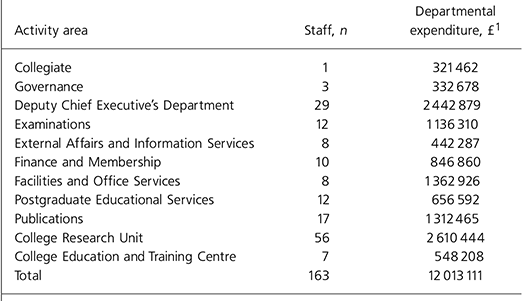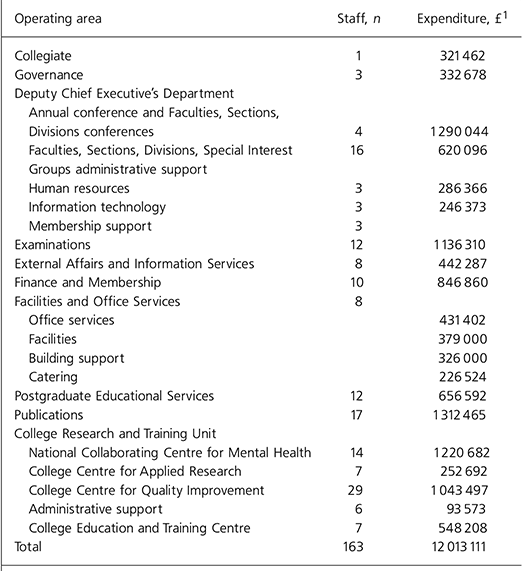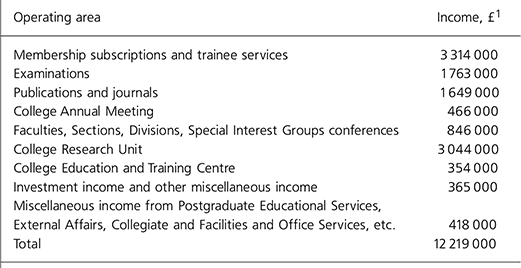The present report is intended to offer a succinct introduction to the purpose, structure and finances of the Royal College of Psychiatrists. It is hoped the report may serve to orientate the general public, new employees and members towards the College, as well as re-orientate long-established members and generally serve the interests of transparency and accountability. It is not intended to provide a full picture of College activities; rather the report aims to outline the College structures and, briefly, summarise the financial fundamentals that underpin such activities. Further details about the College and its activities may be obtained from the Trustees’ Annual Report and the College's Annual Review.
What is the Royal College of Psychiatrists?
The Royal College of Psychiatrists is a charity.
What is the Royal College of Psychiatrists for?
The Royal College of Psychiatrists promotes mental health by:
-
• setting standards and promoting excellence in mental healthcare
-
• improving understanding through research and education
-
• leading, representing, training and supporting psychiatrists
-
• working with patients, carers and their organisations.
During the years 2005-2010 the College intends to pursue these objectives through its strategic plan ‘Standards, Communications and Structures’.
Who is the Royal College of Psychiatrists?
The current membership of the College is approximately 12 900. Of these 8800 are members (MRCPsych) and 2435 fellows (FRCPsych). Pre-membership psychiatric trainees total just under 1000 and other grades, including affiliates and international associates, make up the total.
Exceptionally, the College bestows Honorary Fellowship upon former members or fellows (currently 33 in number) or upon non-members who have made an exceptional contribution to psychiatry, either as lay people or professionals in disciplines related to psychiatry, or in psychiatry in other parts of the world (currently 62 in number).
Vital to the running of the College are the Chief Executive and other staff employed by the College, 156 in number in December 2006.
Who decides in the Royal College of Psychiatrists?
The ultimate authority within the College is its members and fellows. Membership exercises this authority through the Annual General Meeting. It delegates authority for the majority of decision-making to the Central Executive Committee (CEC). The CEC is chaired by the President who is elected directly by the fellows and members. Other elected CEC members include some of the elected College officers (Dean, Registrar, Honorary Treasurer), the Chairs of Faculties, Sections and Divisions and directly elected fellows (2 in total) and members (also 2 in number). In addition to elected members, the CEC has a significant number of appointed members such as Vice-Presidents, Chairs of Committees (e.g. Professional Governance and Ethics Committee) and Directors (e.g. Director of International Affairs). There are also representatives of affiliates, trainees, patients and carers. Finally there are a small number of co-opted individuals (e.g. National Director for Mental Health or his or her Deputy). The elected members of the CEC are trustees of the charity and the President is Chair of the Trustees, who are responsible for the governance of the College.
How is the College structured?
To understand College structure one needs to look at the structure of the College committees and the College staff departments separately. They do not map simply onto each other. The CEC is responsive to, and supported by, the Faculties, Divisions, Sections, the Education, Training and Standards Committee, standing committees of the CEC, special committees of the CEC and Special Interest Groups. Examples of standing committees include the Public Education Committee and the Publications Management Board. Examples of special committees include the Patients and Carers Committee and the Special Committee on Professional Governance and Ethics.
The day-to-day work of Faculties, Divisions, Committees, etc. is overseen by the President and other officers of the College. Vital to the day-to-day running of the Faculties, Divisions, Committees, etc. are their own officers (including Chair, Secretary and Financial Officer). The nearly 160 employees of the College work within ten departments of the College. It is important to repeat that the structure of the departments within the College does not mirror the structure of the CEC and its constituents/committees. The importance of this is that an understanding of the College committee structures does not necessarily give an understanding of the structure of support for these committees. The purpose of this arrangement has been to allow the development of more flexible response on the part of College staff to College officers and committees.
The Departments of the College within which employees work are as follows:
-
• College Office
-
• College Governance
-
• Deputy Chief Executive's Department
-
• Examinations Department
-
• External Affairs and Information Services Department
-
• Finance Department
-
• Facilities and Office Services Department
-
• Postgraduate Educational Services Department
-
• Publications Department
-
• College Research and Training Unit.
Costs of the College Office include the salary and expenses of the Chief Executive, officers’ costs, professional fees, public relations for the Irish College of Psychiatrists and subscriptions to professional bodies (e.g. the Academy of Medical Royal Colleges).
Costs of College Governance include the President's expenses, annual general meeting and election costs, costs of trustees’ meetings and strategic planning processes, and costs relating to preparing statutory accounts, audit, legal advice to trustees, etc.
The Deputy Chief Executive's Department includes human resources, information technology, the conference unit, committee and secretarial support (including Faculty, Section, Division and Special Interest Group support centrally and via the Divisional Offices), and the new Membership support function.
The External Affairs Department and Information Services Department support the areas of public policy work (including parliamentary and media liaison), the production and dissemination of the College's public health information, fundraising activities, campaign activities and the library/information service. The department leads cross-department activities concerned with Membership communication.
The Postgraduate Educational Services Department supports specialist training work, liaison with the Postgraduate Medical and Education Training Board, continuing professional development and the international activities of the College.
What does it all cost?
The expenditure in the year to 31 December 2006 totalled £12 013111. Table 1 lists aggregated activities areas, with numbers of employees allocated on payroll and departmental expenditure. Table 2 breaks down some of the activities areas into more detailed operating areas and lists numbers of employees allocated on payroll and expenditure in each department.
Table 1. Number of employees on payroll and departmental expenditure for each activity area

| Activity area | Staff, n | Departmental expenditure, £1 |
|---|---|---|
| Collegiate | 1 | 321 462 |
| Governance | 3 | 332 678 |
| Deputy Chief Executive's Department | 29 | 2 442 879 |
| Examinations | 12 | 1 136 310 |
| External Affairs and Information Services | 8 | 442 287 |
| Finance and Membership | 10 | 846 860 |
| Facilities and Office Services | 8 | 1 362 926 |
| Postgraduate Educational Services | 12 | 656 592 |
| Publications | 17 | 1 312 465 |
| College Research Unit | 56 | 2 610 444 |
| College Education and Training Centre | 7 | 548 208 |
| Total | 163 | 12 013 111 |
Table 2. Number of employees on payroll and expenditure for each operating area

| Operating area | Staff, n | Expenditure, £1 |
|---|---|---|
| Collegiate | 1 | 321 462 |
| Governance | 3 | 332 678 |
| Deputy Chief Executive's Department | ||
| Annual conference and Faculties, Sections, Divisions conferences | 4 | 1 290 044 |
| Faculties, Sections, Divisions, Special Interest | 16 | 620 096 |
| Groups administrative support | ||
| Human resources | 3 | 286 366 |
| Information technology | 3 | 246 373 |
| Membership support | 3 | |
| Examinations | 12 | 1 136 310 |
| External Affairs and Information Services | 8 | 442 287 |
| Finance and Membership | 10 | 846 860 |
| Facilities and Office Services | 8 | |
| Office services | 431 402 | |
| Facilities | 379 000 | |
| Building support | 326 000 | |
| Catering | 226 524 | |
| Postgraduate Educational Services | 12 | 656 592 |
| Publications | 17 | 1 312 465 |
| College Research and Training Unit | ||
| National Collaborating Centre for Mental Health | 14 | 1 220 682 |
| College Centre for Applied Research | 7 | 252 692 |
| College Centre for Quality Improvement | 29 | 1 043 497 |
| Administrative support | 6 | 93 573 |
| College Education and Training Centre | 7 | 548 208 |
| Total | 163 | 12 013 111 |
Where does the money come from?
The income of the College, £12 219 000 in the year to 31 December 2006, derives from Membership subscriptions, trainee services, examinations, publications and journals, the Annual Meeting of the College, Faculty/Section/Division/Special Interest Group conferences, the College Research Unit, the College Education and Training Centre and investment and other miscellaneous income. Table 3 presents income from each of these activities for the year 2006.
Table 3. Income according to operating area

| Operating area | Income, £1 |
|---|---|
| Membership subscriptions and trainee services | 3 314 000 |
| Examinations | 1 763 000 |
| Publications and journals | 1 649 000 |
| College Annual Meeting | 466 000 |
| Faculties, Sections, Divisions, Special Interest Groups conferences | 846 000 |
| College Research Unit | 3 044 000 |
| College Education and Training Centre | 354 000 |
| Investment income and other miscellaneous income | 365 000 |
| Miscellaneous income from Postgraduate Educational Services, External Affairs, Collegiate and Facilities and Office Services, etc. | 418 000 |
| Total | 12 219 000 |
The 2006 UK and Ireland Membership fee was £376 and Fellowship fee £ 487. A range of discounts is offered on these rates for payment by direct debit or in circumstances of lower earnings or retirement. Overseas subscriptions are lower and are banded by country according to the World Bank assessment of per capita income in each country. The College has additional capital and liquid assets valued at £6 678 000.
It is normal practice for 15% of income to be reserved for the College Development Fund. The College Development Fund was set up in 1995 with the purpose of stabilising the balance of income and expenditure in the College and building up funding for new developments. The Development Fund has supported College campaigns such as ‘Partners in Care’, projects for the benefit of members and one-off activities in line with our charitable objectives. Any balance remaining at the year-end is transferred to the New Building Fund to build up the reserve against the time when the College will need to seek new premises. The current lease is due to expire in 2034.
Why does this paper present figures differently from the annual accounts?
The Royal College of Psychiatrists is fully accountable to the Charity Commission for all its activities, including financial activities. The annual accounts are required to comply with the Statement of Recommended Practice and other requirements of the Charity Commission. These mandate that the accounts are laid out in ways that align reporting directly with the Charity's aims. The present report, in contrast, aims to set out information in a way that makes it as near as possible to the experience of College members.
In the annual accounts references are made to ‘general’ and ‘ restricted’ funds. Restricted funds refer to income generated by the College that may not be used other than for specified (‘restricted’) purposes. Examples of restricted funds include projects at the College Research and Training Unit funded by the Department of Health or charities.
Annual accounts - what are they?
The annual accounts comprise the legal and administrative information, the trustees’ report, the Honorary Treasurer's report, the independent auditor's report and the accounts. The accounts consist of the statement of financial activities, the balance sheet and cash flow statement. They are supported by detailed notes to the accounts. A summarised version is mailed to all College members and the full version is available to anyone (member or non-member) on request. A full set of the accounts is filed on the Charity Commission website (http://www.charity-commission.gov.uk). The statement of financial activities summarises all incoming resources and how they are spent. The balance sheet records the assets and liabilities of the College. Assets include cash, investments, furniture and equipment, stocks and debtors. Liabilities are what the College owes to its creditors. The net assets (assets less liabilities) are represented by funds and reserves. The cash flow statement shows the cash received and spent by the College during the financial year.
What should the reader look for?
The trustees’ report, together with the accounts, is intended to explain events in a narrative format. The financial statements add the numbers. The financial strength of the College can be ascertained via the balance sheet together with the cash flow statement. These should give the reader sufficient information on the type and value of assets held by the College and of its reserves. The surplus or deficit achieved during each financial year is shown on the statement of financial activities.
Discussion
Presenting finances always entails a measure of judgement about what to present and how to do it. Annual external audit ensures that the annual accounts meet relevant standards. The presentation of information in the present paper is fully compatible with annual accounts as well as management accounts.
A regular concern expressed by members is that the College Annual Meeting and Faculty annual conferences are expensive. It is important to realise that fees for conference attendance do not cover all of the conference expenditure. This is because the conference budgets are set without reference to central costs. Such costs, which are excluded in the process of budget setting, include all salary and central office costs associated with the Conference Unit. If these costs were included in conference budgeting, conferences would be very much more expensive. In this sense the College Annual and Faculty and Division conference fees are subsidised significantly by Membership fees.
A related issue is that of pharmaceutical industry and other commercial sponsorship or contribution to College events, particularly conferences. A significant proportion of the Membership wants to see the College completely disassociated from such contributions to its finances, so that the College not only is, but is seen to be, independent of such influence. Such proposals cause much anxiety to those charged with budgeting for conferences, as this can be difficult, even with the subsidy made to such conferences by Membership fees.
Another view is that it would be contrary to the College's charitable aims not to accept ethical contributions to its finances, as such contributions can enhance the College's ability to ethically achieve its objectives. The Registrar is currently leading a review in relation to this issue, and this issue is also under debate by the Academy of Medical Royal Colleges. It may or may not be the case that a further review will be required to look specifically into the relations of the College as a charity with the pharmaceutical industry and other commercial interests in mental health.
Other important issues currently under review include fundraising activities in general and the issue of seeking new premises. The current lease for the building at 17 Belgrave Square comes to an end in 2034. This represents a major financial challenge to the College. Possible options include running the current lease down, extending the current lease or seeking a new building. All options entail significant costs in the long run, some more than others.
Conclusions
The Royal College of Psychiatrists is a charity which aims to promote mental health. The College's charitable aims and charitable status demand the highest transparency possible. The present report is offered in the service of this transparency and informed debate.






eLetters
No eLetters have been published for this article.